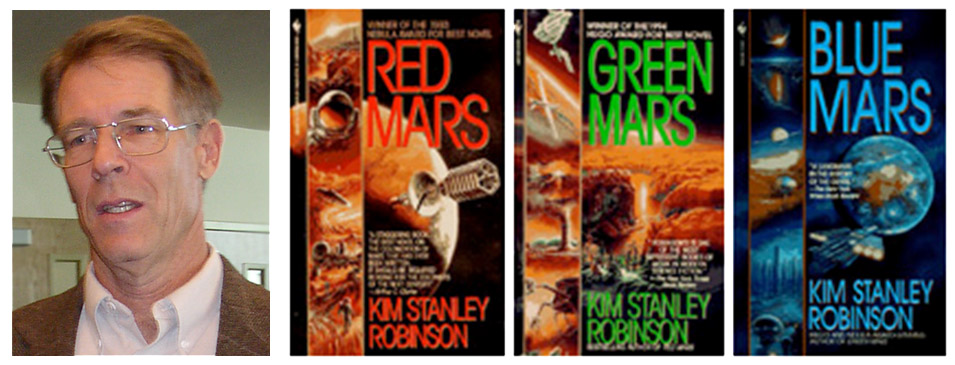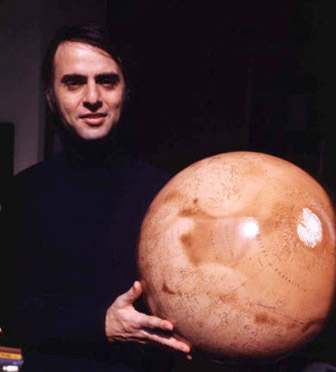Team:Valencia/Project
From 2010.igem.org
(→Terraforming of Mars) |
(→Terraforming of Mars) |
||
| Line 42: | Line 42: | ||
== Terraforming of Mars == | == Terraforming of Mars == | ||
''Terraforming'' of a planetary body (planet or moon) or ''planetary ecosynthesis'' is the hypothetical process of deliberately modifying its atmosphere composition, temperature, topography, or ecology to be similar to those of Earth to make it habitable for Terran organism, including humans. Terraforming is a common concept in science fiction. In fact, Jack Williamson, a science fiction writer, coined the term in 1942. But the first to use the concept was H.G. Wells in his ''The War of the Worlds'' (1898), where the martian invaders start a terraforming-reverse process in order to change our planet for their own benefit. Recent work in fiction exploring this concept includes the wonderful ''Mars Trilogy'' by Kim Stanley Robinson that has filled our dreams about the red planet with astonishing details. | ''Terraforming'' of a planetary body (planet or moon) or ''planetary ecosynthesis'' is the hypothetical process of deliberately modifying its atmosphere composition, temperature, topography, or ecology to be similar to those of Earth to make it habitable for Terran organism, including humans. Terraforming is a common concept in science fiction. In fact, Jack Williamson, a science fiction writer, coined the term in 1942. But the first to use the concept was H.G. Wells in his ''The War of the Worlds'' (1898), where the martian invaders start a terraforming-reverse process in order to change our planet for their own benefit. Recent work in fiction exploring this concept includes the wonderful ''Mars Trilogy'' by Kim Stanley Robinson that has filled our dreams about the red planet with astonishing details. | ||
| - | |||
[[Image:Valencia_robinson.jpg|thumb|center|600px|Kim Stanley Robinson with his ''Mars Trilogy'' has been one of the major inspirators of our work. They are really worth reading books.]] | [[Image:Valencia_robinson.jpg|thumb|center|600px|Kim Stanley Robinson with his ''Mars Trilogy'' has been one of the major inspirators of our work. They are really worth reading books.]] | ||
| - | |||
In the scientific field, the first one who talk about Terraforming of Mars was Carl Sagan (1971) in a technical review: ''Planetary engineering on Mars''. In [http://www.youtube.com/watch?v=XzVYwyxidDY ''Blues for the Red Planet''], the fifth episode of his mythical television series '' Cosmos: A personal Voyage'', he exposes his ideas to the public. Sagan’s plan for terraforming of Mars implies seeding its polar casquets with dark plants. These plants will be artificially selected or genetically modified to resist and “survive” the harsh conditions of Mars climate. The positive point gained with this seeding will be realeasing oxygen and darkening the martian surface, melting down the polar casquets and liberating the ancient martian atmosphere trapped in there. This fusion water could be transported to the equator by the construction of a network of channels, similarly to the one Percival Lowell believed an inexistent Martian civilization had constructed. Sagan’s opinion about the ethics of this terraforming process, in the case the planet result not sterile is categorical: | In the scientific field, the first one who talk about Terraforming of Mars was Carl Sagan (1971) in a technical review: ''Planetary engineering on Mars''. In [http://www.youtube.com/watch?v=XzVYwyxidDY ''Blues for the Red Planet''], the fifth episode of his mythical television series '' Cosmos: A personal Voyage'', he exposes his ideas to the public. Sagan’s plan for terraforming of Mars implies seeding its polar casquets with dark plants. These plants will be artificially selected or genetically modified to resist and “survive” the harsh conditions of Mars climate. The positive point gained with this seeding will be realeasing oxygen and darkening the martian surface, melting down the polar casquets and liberating the ancient martian atmosphere trapped in there. This fusion water could be transported to the equator by the construction of a network of channels, similarly to the one Percival Lowell believed an inexistent Martian civilization had constructed. Sagan’s opinion about the ethics of this terraforming process, in the case the planet result not sterile is categorical: | ||
Revision as of 17:54, 23 October 2010
Time goes by...
(El tiempo pasa...)
Follow us:

Our main sponsors:

Our institutions:

Visitor location:
Terraforming of Mars
Terraforming of a planetary body (planet or moon) or planetary ecosynthesis is the hypothetical process of deliberately modifying its atmosphere composition, temperature, topography, or ecology to be similar to those of Earth to make it habitable for Terran organism, including humans. Terraforming is a common concept in science fiction. In fact, Jack Williamson, a science fiction writer, coined the term in 1942. But the first to use the concept was H.G. Wells in his The War of the Worlds (1898), where the martian invaders start a terraforming-reverse process in order to change our planet for their own benefit. Recent work in fiction exploring this concept includes the wonderful Mars Trilogy by Kim Stanley Robinson that has filled our dreams about the red planet with astonishing details.
In the scientific field, the first one who talk about Terraforming of Mars was Carl Sagan (1971) in a technical review: Planetary engineering on Mars. In [http://www.youtube.com/watch?v=XzVYwyxidDY Blues for the Red Planet], the fifth episode of his mythical television series Cosmos: A personal Voyage, he exposes his ideas to the public. Sagan’s plan for terraforming of Mars implies seeding its polar casquets with dark plants. These plants will be artificially selected or genetically modified to resist and “survive” the harsh conditions of Mars climate. The positive point gained with this seeding will be realeasing oxygen and darkening the martian surface, melting down the polar casquets and liberating the ancient martian atmosphere trapped in there. This fusion water could be transported to the equator by the construction of a network of channels, similarly to the one Percival Lowell believed an inexistent Martian civilization had constructed. Sagan’s opinion about the ethics of this terraforming process, in the case the planet result not sterile is categorical:
"If there is life on Mars, then I believe we should do nothing to disturb that life. Mars, then, belongs to the Martians, even if they are microbes."
In the last years several review works about the concept of terraforming have appeared in the scientific literature. McKay and Marinova (2001) review the general aspects regarding the planetary ecosynthesis in the red planet and the ethics of that process. Graham (2004) has focused in the biological aspects of the creation of a biosphere on Mars and has delineated the stages of such a process. Finally Beech has written a book Terraforming: The Creation of Habitable Worlds (2009) in which the terraforming process is exhaustively analised. To delve deeper into this exciting process, we recommend the reading of such works and the introduction to the survey of the ethics of terraforming that we have written.
Our project
Summary
The implementation of the project has several sub-objectives.
Martian conditions Simulation Chamber (MSC)
We reproduce some of the characteristics that make difficult the life in Mars with this chamber. Among them we can have the atmospheric pressure between 7 and 10 mbar and the gases composition (mainly carbon dioxid). Once we achieve this humble goal, we can use the MSC to try our engineered microorganisms and observe its behavior: if it grows, just only survives without growing or dies. It’s a very important part of the project because is an easy way to prove whether the microbes can grow or at least survive in an environment with such limitations as martian atmosphere can be.
Red-house
In the other hand, in the beginnings our microorganisms are going to need an appropriate (or cozy) environment to grow. Regarding this, we are going to build a “Red-House” (an analogy with a greenhouse but in the red planet) in order to preserve the growing cultures until the atmospheric conditions reach the proper values to the microbial growth. The Red-house is a device designed to protect the microorganisms from the harsh conditions of: temperature, pressure and radiation. Once the device is thermally isolated from the exterior media, we are trying to warm its interior with electricity generated using wind turbines.
Prionic Switch test
The third phase is the test of the prionic switch in the original configuration. We want to test how the prionic switch respond to heat shock and another stress inputs, and if it inhibits the expression of the betaGAL reporter. In this situation we also want to see the effect of “the color” of the cultures in its surface temperature. Hopefully betaGAL blue is better (warmer) than white and red (Martian red).
LEA Experiments in E. Coli
The fourth part involves dealing with violent temperature changes of the Martian surface. To do this we will implement the expression of LEA (late embryogenesis abundant) “antifreeze” protein. Thus, we want to verify the resistance to cold shock and salt stress of the E. coli cultures who which express LEA and compare this result with the ones who doesn't (control cultures). This brings the new problem of which control cultures we shall use. The same E.coli with the pM2 plasmid but without the insert (this is probably the best option but the more difficult one) What happened with this issue guys???
Expresing LEA in Yeasts
The fifth part is to express LEA in Saccharomices Cereviciae. We have the W303 strain. We need to put together the LEA gene in an expression vector for Eukaryotes with a constitutive promoter and probably with a HSP promoter. (Update on this topic, please)
Melanin sinthesis modulation in Yeasts with a temperature activated prionic switch
Explanation needed here (Jose maybe???)
 "
"

